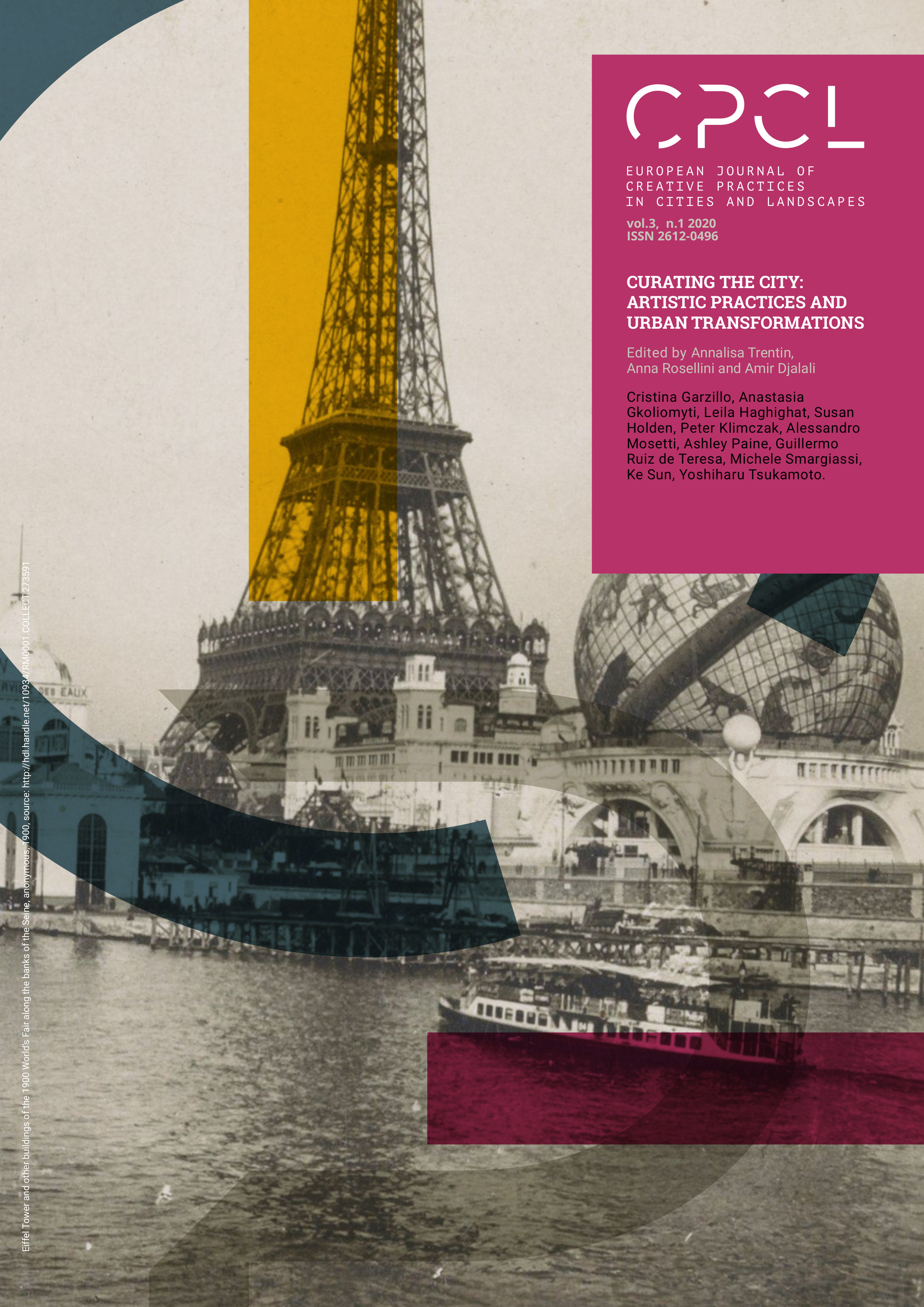Surrealist Curation: Urban Domesticity Through the Surrealist Poetics of Analogy
DOI:
https://doi.org/10.6092/issn.2612-0496/10156Keywords:
Surrealist Curation, Urban Domesticity, Urban Space, Architectural Surrealism, Poetic AnalogyAbstract
The tactic of surrealist poetic analogy forms the surrealist curation that functions as an agent that occupies, engages, and ultimately transforms the city and its built environment that surrounds us. In the case of Le Corbusier’s roof terrace of the Beistegui apartment in Paris, Le Corbusier uses intentional movements and visual analogical compositions to dictate a curated urban experience in a domestic space. The surrealist curation unfolds the tenacious relationship between house and city through an analogical narrative, in which the house extends its boundaries to the public realm and brings domesticity into the city. In the case of Alÿs’ Modern Procession in New York City, the carried art objects, the music performed during the procession, and the movements of the participants domesticate urban streets by relocating art objects from the interior of a private museum institution to the public urban space. The juxtaposed urban elements enact a poetic transformation that facilitates the surrealist curation to assemble an “oneiric house” filled with fantasy. The paper argues that the surrealist curation evokes “dream images” in the city that transcends the tangible material city into a dream entity and looks beyond the built environment to understand the city. By implementing the surrealist curation one can further challenge the perceptions of urban spatial boundaries and investigate the theoretical and historical overlaps between urban domesticity and surrealist imagination. Surrealist curation criticizes the homogenous quantitative treatments of urbanism and their analytical data-driven approaches to urban transformation, calls for the examination of poetic relationships in our cities through visual fantasies, corporeal kinesthesia, and alternative narratives of reveries.
References
Alÿs, Francis. The Modern Procession. New York: Public Art Fund, 2004.
Anderson, Ross. “All of Paris, Darkly: Le Corbusier’s Beistegui Apartment, 1929-1931.” Valencia, Spain, 2015. https://doi.org/10.4995/LC2015.2015.928.
Benjamin, Walter. Reflections: Essays, Aphorisms, Autobiographical Writings. Edited by Peter Demetz. Translated by Edmund Jephcott. New York: Schocken Books, 1978.
———. The Arcades Project. Translated by Howard Eiland and Kevin McLaughlin. Cambridge, MA: Harvard University Press, 1999.
———. Walter Benjamin: Selected Writings, Volume 2: 1927-1934. Edited by Michael W. Jennings, Howard Eiland, and Gary Smith. Cambridge, MA: Harvard University Press, 1999.
Breton, André. Manifestes du surréalisme. Paris, France: Jean-Jacques Pauvert, 1962.
———. Manifestoes of Surrealism. Ann Arbor: University of Michigan Press, 1969.
Buck-Morss, Susan. The Dialectics of Seeing: Walter Benjamin and the Arcades Project. Cambridge, MA: MIT Press, 1991.
Chaplin, Sarah, and Alexandra Stara, eds. Curating Architecture and the City. New York and London: Routledge, 2009. https://doi.org/10.4324/9780203876381
Colomina, Beatriz. Privacy and Publicity: Modern Architecture as Mass Media. Cambridge, MA: MIT Press, 1994.
Corbusier, Le. Towards a New Architecture. Reprint edition. New York: Dover Publications, 1985.
Foucault, Michel. The Order of Things: An Archaeology of the Human Sciences. New York and London: Routledge, 2002.
Gorlin, Alexander. “The Ghost in the Machine: Surrealism in the Work of Le Corbusier.” Perspecta 18 (1982): 51–65. https://doi.org/10.2307/1567035.
Harrison, Robert Pogue. The Dominion of the Dead. 1st edition. Chicago: University Of Chicago Press, 2003.
Pérez-Gómez, Alberto. Attunement: Architectural Meaning After the Crisis of Modern Science. Cambridge, MA: MIT Press, 2016. https://doi.org/10.7551/mitpress/10703.001.0001
Švácha, Rostislav. “Surrealism and Czech Functionalism.” Translated by Jan Valeška. Umeni / Art 55, no. 4 (August 2007): 316–28. https://doi.org/10.2478/v10008-007-0009-x
Veselý, Dalibor. “Surrealism and the Latent World of Creativity.” Umeni / Art 59, no. 3/4 (June 2011): 267–73. http://lp.hscl.ufl.edu/login?url=http://search.ebscohost.com/login.aspx?direct=true&AuthType=ip,uid&db=asu&AN=65463658&site=eds-live.
Vidler, Anthony. The Architectural Uncanny: Essays in the Modern Unhomely. Cambridge, MA: MIT Press, 1992.
Published
How to Cite
Issue
Section
License
Copyright (c) 2020 Ke Sun

This work is licensed under a Creative Commons Attribution 4.0 International License.




